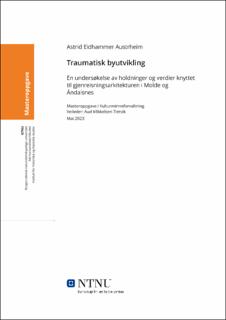| dc.contributor.advisor | Tretvik, Aud Mikkelsen | |
| dc.contributor.author | Austrheim, Astrid Eidhammer | |
| dc.date.accessioned | 2023-07-11T17:29:00Z | |
| dc.date.available | 2023-07-11T17:29:00Z | |
| dc.date.issued | 2023 | |
| dc.identifier | no.ntnu:inspera:144933143:37063954 | |
| dc.identifier.uri | https://hdl.handle.net/11250/3078067 | |
| dc.description.abstract | Gjenreisningsarkitekturen er noe som engasjerer i både positiv og negativ retning. Enten det er begeistring eller frustrasjon, så er det en kulturminnetype man ikke forholder seg passivt til. Denne oppgaven undersøker hvordan lokalbefolkningen i Molde og Åndalsnes oppfatter gjenreisningsarkitektur, og om deres oppfatning avviker fra forvaltningens oppfatning. En komparativ analyse blir utført mellom Molde og Åndalsnes, samt mellom lokalbefolkning og forvaltning for å bidra til en dypere forståelse av kulturminnevern og gjenreisningsarkitektur i ulike kontekster. Det teoretiske grunnlaget i oppgaven er den autoriserte kulturarvsdiskursen, stedsidentitet, stedsutvikling, medvirkning samt gjeldende lovverk. Det er utført spørreundersøkelse blant lokalbefolkningen og intervjuer med forvaltningen for å få innsikt i deres perspektiver på gjenreisningsarkitekturen. Hovedfunnet i oppgaven viser at forvaltningen og lokalbefolkningen har delvis ulike oppfatninger om gjenreisningsarkitektur, men at det ikke er så store avvik som man kanskje skulle tro. Analysen konkluderer med at det er viktig å ta hensyn til lokalbefolkningens synspunkter for å oppnå en mer inkluderende, bærekraftig og kunnskapsbasert tilnærming til kulturminneforvaltning og gjenreisningsarkitektur. | |
| dc.description.abstract | Post-war architecture heritage is something that engages people in both a positively and negatively direction. Whether it's enthusiasm or frustration, it's a type of cultural heritage that people don't passively relate to. This assignment examines how the local population in Molde and Åndalsnes perceives their post-war architecture, and whether their perception deviates from that of the municipal and county administration. A comparative analysis is carried out between Molde and Åndalsnes, as well as between the local population and the administrations to contribute to a deeper understanding of cultural heritage preservation and post-war architecture in different contexts. The theoretical foundation of the assignment is the authorized heritage discourse, place identity, place development, participation, and applicable legislation. A survey has been conducted among the local population and interviews with the administrations to gain insight into their perspectives on the post-war architecture. The main finding of the assignment shows that the authorities and the local population have partly different perceptions of post-war architecture, but that the deviations is not as clear as one might think. The analysis concludes that it is important to take into account the perspectives of the local population to achieve a more inclusive, sustainable, and knowledge-based approach to cultural heritage management and post-war architecture. | |
| dc.language | nob | |
| dc.publisher | NTNU | |
| dc.title | Traumatisk byutvikling. En undersøkelse av holdninger og verdier knyttet til gjenreisningsarkitekturen i Molde og Åndalsnes | |
| dc.type | Master thesis | |
